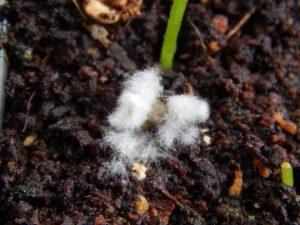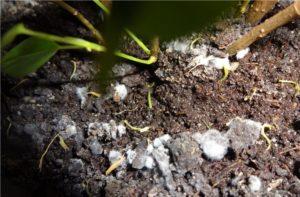Why the earth in a pot is covered with a white coating and how to resist mold
Most indoor plant lovers have noticed a white coating on the ground at least once. Such an unpleasant phenomenon is quite dangerous for the healthy growth and development of "green pets", so every responsible florist is simply obliged to find out the causes of this disease and methods of dealing with it.
Content
Causes of white plaque in flower pots
White coating on the surface of the soil in a flower pot is most often a sign of mold. The mold can be silvery white or pale brown and looks like soft fluff. Causes of mold there may be several on earth:
- heavy composition of the soil;
- lack of a drainage layer and holes at the bottom of the pot;
- improper watering of the plant;
- excess fertilizer in the soil;
- incorrectly selected pot size for the plant;
- using soil contaminated with fungal spores.
What is dangerous mold for a plant
It is necessary to fight the mold that has appeared on the ground immediately, after the first signs of damage are detected. This fungus is very dangerous for plants and can lead to the following consequences:
- mold disrupts the absorption of nutrients by plants;
- there are problems with the circulation of oxygen in the soil and, as a result, the roots of the plant suffer;
- a fungus on the surface of the earth makes it difficult for the evaporation of moisture and because of this, rotting of the root system begins;
- in advanced cases, the fungus can even lead to the complete death of the plant.
How to get rid of mold in flower pots
The fight against a dangerous fungus can be carried out in different ways, each of which is effective in its own way.
The mechanical method involves the removal of the top contaminated layer of the earth and the introduction of new clean soil in its place. If the fungal infection is very strong, then it is easiest to transplant the plant into a new pot using a clean substrate.
After transplanting, it is very important to regularly loosen the soil and water the plant properly. A new portion of water must be added to the pot only after the top layer of the earth has completely dried.
The addition of special components with bactericidal properties to the soil will help get rid of the fungus. The most effective, flower growers consider the use sphagnum moss and charcoal.
Also, in the fight against mold, the drug showed a good result. Phytosporin. It contains special beneficial bacteria that prevent the appearance of rot and fungi.
A fairly popular method of fighting mold is the use of citric acid. To do this, when watering plants, a small amount of lemon juice or citric acid is added to the water. Such a solution favorably affects the plant and is detrimental to the fungus.
Prevention of mold in flower pots
Mold on the soil always has a negative impact on the health of the plant, so it is best to prevent it from appearing at all. To prevent mold in the soil in flower pots, the following recommendations will help:
- pay special attention to the irrigation regime and prevent waterlogging of the soil;
- use only flower pots with special holes at the bottom;
- be sure to lay out a drainage layer on the bottom of the pot before planting;
- water the plant exclusively with soft water;
- when planting new plants, use a pot of a suitable size;
- loosen the soil in the pot as often as possible;
- use high-quality soil when transplanting;
- at least once a month, disinfect the soil with a solution of potassium permanganate;
- mulch the soil in a flower pot with sand, charcoal or expanded clay.
Conclusion
Despite the fact that indoor flowers live indoors, they often become victims of various diseases and pests. Mold on the soil is a rather dangerous disease and untimely start of treatment can lead to very unpleasant consequences for the plant.

